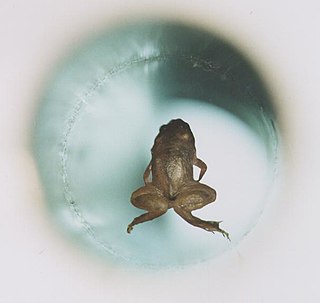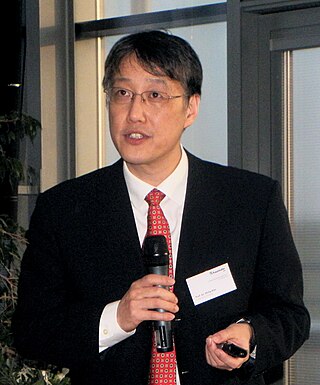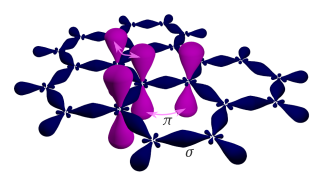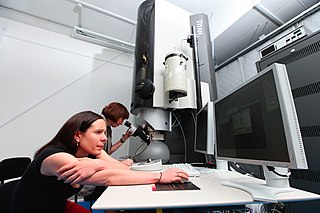Related Research Articles

The Ig Nobel Prize is a satiric prize awarded annually since 1991 to celebrate ten unusual or trivial achievements in scientific research. Its aim is to "honor achievements that first make people laugh, and then make them think." The name of the award is a pun on the Nobel Prize, which it parodies, and on the word ignoble.

Sir Michael Victor Berry,, is a mathematical physicist at the University of Bristol, England.

Albert Fert is a French physicist and one of the discoverers of giant magnetoresistance which brought about a breakthrough in gigabyte hard disks. Currently, he is an emeritus professor at Paris-Saclay University in Orsay, scientific director of a joint laboratory between the Centre national de la recherche scientifique and Thales Group, and adjunct professor at Michigan State University. He was awarded the 2007 Nobel Prize in Physics together with Peter Grünberg.
John Michael David Coey, known as Michael Coey, is a Belfast-born experimental physicist working in the fields of magnetism and spintronics. He got a BA in Physics at Jesus College, Cambridge (1966), and a PhD from University of Manitoba (1971) for a thesis on "Mössbauer Effect of 57Fe in Magnetic Oxides" with advisor Allan H. Morrish. Trinity College Dublin (TCD), where he has been in the physics department since 1978, awarded him ScD (1987) and the University of Grenoble awarded him Dip. d'Habilitation (1986) and an honorary doctorate (1994). He served as Erasmus Smith's Professor of Natural and Experimental Philosophy at TCD from 2007 to 2012.

Sir Andre Konstantin Geim is a Russian-born Dutch-British physicist working in England in the School of Physics and Astronomy at the University of Manchester.

Philip Kim is a South Korean physicist. He is a condensed matter physicist known for study of quantum transport in carbon nanotubes and graphene, including observations of quantum Hall effects in graphene.
The Nevill Mott Medal and Prize is an award presented in selected years by the Institute of Physics in the United Kingdom, for distinguished research in condensed matter or materials physics. It was first established in 1997 thanks to a donation from Sir Nevill Mott's family. Sir Nevill Mott was one of the outstanding British condensed matter theorists and won a Nobel Prize in Physics in 1977. He died in 1996. The award consists of a silver medal and a prize of £1000.

Sir Konstantin Sergeevich Novoselov is a Russian-British physicist, and a professor at the Centre for Advanced 2D Materials, National University of Singapore. He is also the Langworthy Professor in the School of Physics and Astronomy at the University of Manchester. His work on graphene with Andre Geim earned them the Nobel Prize in Physics in 2010.
Spin engineering describes the control and manipulation of quantum spin systems to develop devices and materials. This includes the use of the spin degrees of freedom as a probe for spin based phenomena. Because of the basic importance of quantum spin for physical and chemical processes, spin engineering is relevant for a wide range of scientific and technological applications. Current examples range from Bose–Einstein condensation to spin-based data storage and reading in state-of-the-art hard disk drives, as well as from powerful analytical tools like nuclear magnetic resonance spectroscopy and electron paramagnetic resonance spectroscopy to the development of magnetic molecules as qubits and magnetic nanoparticles. In addition, spin engineering exploits the functionality of spin to design materials with novel properties as well as to provide a better understanding and advanced applications of conventional material systems. Many chemical reactions are devised to create bulk materials or single molecules with well defined spin properties, such as a single-molecule magnet. The aim of this article is to provide an outline of fields of research and development where the focus is on the properties and applications of quantum spin.
The Manchester Centre for Mesoscience and Nanotechnology is a centre for interdisciplinary research in mesoscience and nanotechnology headed by Andre Geim at the University of Manchester. The purpose of the centre is to allow researchers to construct devices from a few micrometres down to 10 nanometres in size. It was opened by Lord Sainsbury on 7 April 2003.
Allan H. MacDonald is a theoretical condensed matter physicist and the Sid W. Richardson Foundation Regents Chair Professor of Physics at The University of Texas at Austin. He was born in Antigonish, Nova Scotia, Canada, and attended local schools completing a B.S. at St. Francis Xavier University in 1973. He completed his Ph.D.in physics at The University of Toronto in 1978, working with S.H. Vosko on relativistic generalizations of density functional theory, and on the application of density functional theory to magnetism in metals.

Helen Frances Gleeson OBE FInstP is a British physicist who specialises in soft matter and liquid crystals. She is Cavendish Professor and former Head of the School of Physics at the University of Leeds.
Tomasz Dietl is a Polish physicist, a professor and a head of Laboratory for Cryogenic and Spintronic Research at the Institute of Physics, Polish Academy of Sciences and professor of The Institute of Theoretical Physics at University of Warsaw. His research interest includes semiconductors, spintronics and nanotechnology. With over 20,000 citations he is considered one of the leading Polish physicists.

Mikhail Iosifovich Katsnelson is a Dutch professor of theoretical physics of Russian descent. He works at Radboud University Nijmegen where he specializes in theoretical solid state physics and many-body quantum physics.

Graphene is a semimetal whose conduction and valence bands meet at the Dirac points, which are six locations in momentum space, the vertices of its hexagonal Brillouin zone, divided into two non-equivalent sets of three points. The two sets are labeled K and K'. The sets give graphene a valley degeneracy of gv = 2. By contrast, for traditional semiconductors the primary point of interest is generally Γ, where momentum is zero. Four electronic properties separate it from other condensed matter systems.

Single-layer graphene was first unambiguously produced and identified in 2004, by the group of Andre Geim and Konstantin Novoselov, though they credit Hanns-Peter Boehm and his co-workers for the experimental discovery of graphene in 1962; while it had been explored theoretically by P. R. Wallace in 1947. Boehm et al. introduced the term graphene in 1986.
Cinzia Casiraghi is a Professor of Nanoscience in the Department of Chemistry at the University of Manchester and National Graphene Institute in the UK.

Sarah Jane Haigh is a Professor in the School of Materials at the University of Manchester. She investigates nanomaterials using transmission electron microscopy, including two-dimensional materials such as graphene.
Pablo Jarillo-Herrero is a Spanish physicist and current Cecil and Ida Green Professor of Physics at Massachusetts Institute of Technology (MIT).

Antonio Helio de Castro Neto is a Brazilian-born physicist. He is the founder and director of the Centre for Advanced 2D Materials at the National University of Singapore. He is a condensed matter theorist known for his work in the theory of metals, magnets, superconductors, graphene and two-dimensional materials. He is a distinguished professor in the Departments of Materials Science Engineering, and physics and professor at the Department of Electrical and Computer Engineering. He was elected as a fellow of the American Physical Society in 2003. In 2011 he was elected as a fellow of the American Association for the Advancement of Science.
References
- 1 2 "Prof Irina Grigorieva | The University of Manchester". www.research.manchester.ac.uk. Retrieved 2 July 2019.
- 1 2 "Irina Grigorieva | Royal Society". royalsociety.org. Retrieved 2 July 2019.
- 1 2 "The godfather of graphene". 1843magazine.com. 12 August 2014. Retrieved 2 July 2019.
- ↑ Clegg, Brian (5 July 2018). The Graphene Revolution: The weird science of the ultra-thin. Icon Books. ISBN 9781785783777.
- ↑ says, Clive Richardson. "Secret of Scientific Creativity revealed by Andre Geim". Science Museum Blog. Retrieved 2 July 2019.
- ↑ "Irina Grigorieva (The University of Manchester)". www.condmat.physics.manchester.ac.uk. Retrieved 2 July 2019.
- 1 2 Administrator, System (2 June 2003). "Spiderman comes to Manchester". The Engineer. Archived from the original on 2 July 2019. Retrieved 2 July 2019.
- ↑ "Graphene Updates - The Graphene Council". thegraphenecouncil.org. Retrieved 2 July 2019.
- 1 2 "Professor Irina Grigorieva awarded the 2019 David Tabor medal and prize". Professor Irina Grigorieva awarded the 2019 David Tabor medal and prize. Retrieved 2 July 2019.
- ↑ "Graphene Turned Magnetic by University of Manchester Researchers". SciTechDaily. 9 January 2012. Retrieved 2 July 2019.
- ↑ Sepioni, M.; Nair, R. R.; Rablen, S.; Narayanan, J.; Tuna, F.; Winpenny, R.; Geim, A. K.; Grigorieva, I. V. (12 November 2010). "Limits on Intrinsic Magnetism in Graphene". Physical Review Letters. 105 (20): 207205. arXiv: 1007.0423 . Bibcode:2010PhRvL.105t7205S. doi:10.1103/PhysRevLett.105.207205. PMID 21231263. S2CID 17052481.
- ↑ Nair, R. R.; Sepioni, M.; Tsai, I-Ling; Lehtinen, O.; Keinonen, J.; Krasheninnikov, A. V.; Thomson, T.; Geim, A. K.; Grigorieva, I. V. (10 January 2012). "Spin-half paramagnetism in graphene induced by point defects". Nature Physics. 8 (3): 199–202. arXiv: 1111.3775 . Bibcode:2012NatPh...8..199N. doi:10.1038/nphys2183. ISSN 1745-2473. S2CID 51820492.
- ↑ "Graphene magnetism: Defects are not enough". Nature Nanotechnology. 6 February 2012. doi: 10.1038/nnano.2012.16 . ISSN 1748-3395.
- ↑ Admin (26 August 2015). "Graphene magnetic sensor more sensitive than silicon". Environmental Engineering News Online. Retrieved 2 July 2019.
- ↑ "'Holy grail of spintronics': Manchester scientist discovers graphene can be made magnetic at flick of switch | Mancunian Matters". mancunianmatters.co.uk. Retrieved 2 July 2019.
- ↑ "Manchester scientists find remarkable magnetic property of graphene". Financial Times. Retrieved 2 July 2019.
- ↑ authors, Guest (15 September 2016). "Dawn of the Age of 2D Materials". Science and Industry Museum blog. Retrieved 2 July 2019.
- ↑ "Graphene balloons don't burst under pressure". Materials Today. Retrieved 2 July 2019.
- 1 2 Admin (13 January 2016). "New use discovered for graphene". Laboratory News. Retrieved 2 July 2019.
- ↑ "David Tabor medal recipients". iop.org. Retrieved 2 July 2019.
- ↑ "'I'm an alien among my own, and on my own among aliens' says 'father of graphene'". The Independent. 9 November 2014. Retrieved 2 July 2019.
- ↑ "Governors". Withington Girls' School. Retrieved 2 July 2019.